中美企业文化比较研究
- 格式:doc
- 大小:88.00 KB
- 文档页数:14
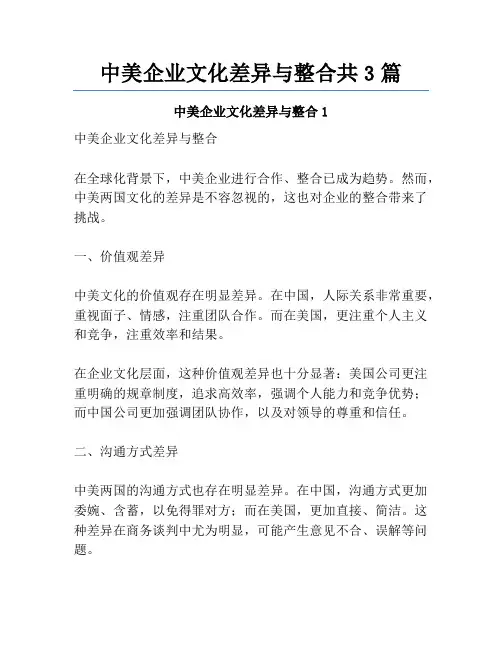
中美企业文化差异与整合共3篇中美企业文化差异与整合1中美企业文化差异与整合在全球化背景下,中美企业进行合作、整合已成为趋势。
然而,中美两国文化的差异是不容忽视的,这也对企业的整合带来了挑战。
一、价值观差异中美文化的价值观存在明显差异。
在中国,人际关系非常重要,重视面子、情感,注重团队合作。
而在美国,更注重个人主义和竞争,注重效率和结果。
在企业文化层面,这种价值观差异也十分显著:美国公司更注重明确的规章制度,追求高效率,强调个人能力和竞争优势;而中国公司更加强调团队协作,以及对领导的尊重和信任。
二、沟通方式差异中美两国的沟通方式也存在明显差异。
在中国,沟通方式更加委婉、含蓄,以免得罪对方;而在美国,更加直接、简洁。
这种差异在商务谈判中尤为明显,可能产生意见不合、误解等问题。
三、组织结构差异中美企业的组织结构存在一定差异。
在美国,公司的决策偏向于平面化和去中心化,由每个部门的负责人共同管理。
而在中国,公司的结构更趋向于集中化,领导者的权威和决策更加集中。
四、员工关系差异在管理员工方面,中美两国也存在巨大差异。
在美国,公司对员工的要求更高,员工获得更多自由度和选择空间,也更加重视员工的个人成长和福利。
而在中国,员工与公司的关系更像家庭,更加注重保障员工的收入和就业机会。
如何整合?为了实现跨文化企业的顺利整合,企业需要采取以下措施:一、建立尊重差异的文化企业应尊重中美文化的差异,采取开放的文化政策,了解、理解和包容跨文化企业中不同的文化特点和习惯,形成温馨、和谐、开放和尊重的企业文化,让员工在工作中感到舒适和自由,提高员工的工作热情和创造力。
二、教育员工文化差异企业需要培训员工对文化差异的认识和理解,提高他们对不同文化的包容性和接纳能力,避免因为文化差异而产生的误解和冲突。
三、建立多元化的管理团队企业应该建立多元化的管理团队,包括不同国家的员工,以便在企业整合时有能力管理不同文化的员工。
四、促进沟通和交流为促进不同文化背景的员工之间的沟通和交流,企业可以采用多种沟通方法,例如建立员工服务中心、制定多元化的员工福利计划等,以此建立员工和企业之间的更好的关系,并帮助他们更好地适应不同文化的差异。
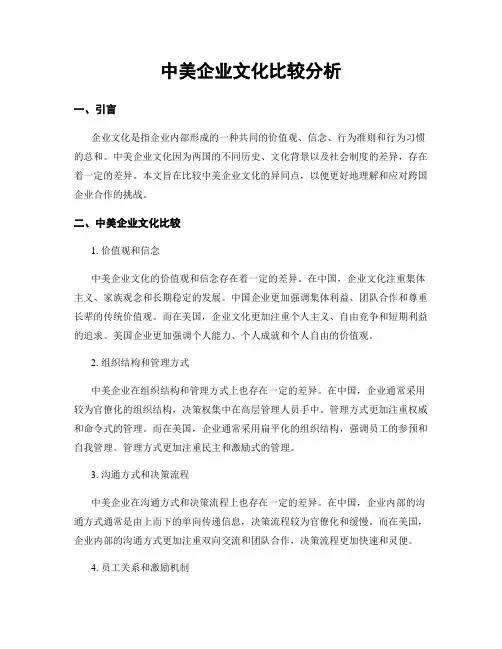
中美企业文化比较分析一、引言企业文化是指企业内部形成的一种共同的价值观、信念、行为准则和行为习惯的总和。
中美企业文化因为两国的不同历史、文化背景以及社会制度的差异,存在着一定的差异。
本文旨在比较中美企业文化的异同点,以便更好地理解和应对跨国企业合作的挑战。
二、中美企业文化比较1. 价值观和信念中美企业文化的价值观和信念存在着一定的差异。
在中国,企业文化注重集体主义、家族观念和长期稳定的发展。
中国企业更加强调集体利益、团队合作和尊重长辈的传统价值观。
而在美国,企业文化更加注重个人主义、自由竞争和短期利益的追求。
美国企业更加强调个人能力、个人成就和个人自由的价值观。
2. 组织结构和管理方式中美企业在组织结构和管理方式上也存在一定的差异。
在中国,企业通常采用较为官僚化的组织结构,决策权集中在高层管理人员手中。
管理方式更加注重权威和命令式的管理。
而在美国,企业通常采用扁平化的组织结构,强调员工的参预和自我管理。
管理方式更加注重民主和激励式的管理。
3. 沟通方式和决策流程中美企业在沟通方式和决策流程上也存在一定的差异。
在中国,企业内部的沟通方式通常是由上而下的单向传递信息,决策流程较为官僚化和缓慢。
而在美国,企业内部的沟通方式更加注重双向交流和团队合作,决策流程更加快速和灵便。
4. 员工关系和激励机制中美企业在员工关系和激励机制上也存在一定的差异。
在中国,企业更加注重员工的忠诚度和长期稳定的就业关系。
激励机制主要通过提供稳定的工作环境、福利待遇和晋升机会来实现。
而在美国,企业更加注重员工的个人能力和成就,激励机制主要通过薪酬激励、晋升机会和个人成长空间来实现。
5. 创新和风险承担中美企业在创新和风险承担上也存在一定的差异。
在中国,企业更加注重稳定和风险规避,创新意识相对较弱。
而在美国,企业更加注重创新和风险承担,鼓励员工提出新的想法和尝试新的方法。
三、中美企业文化的影响和应对策略1. 影响中美企业文化的差异对跨国企业合作产生了一定的影响。
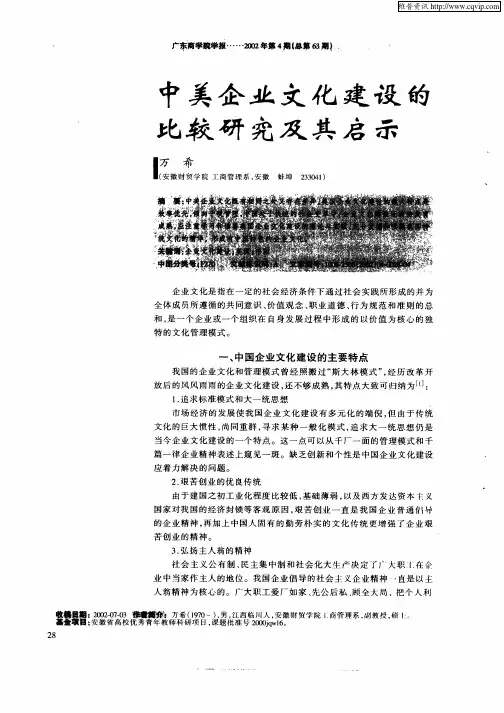
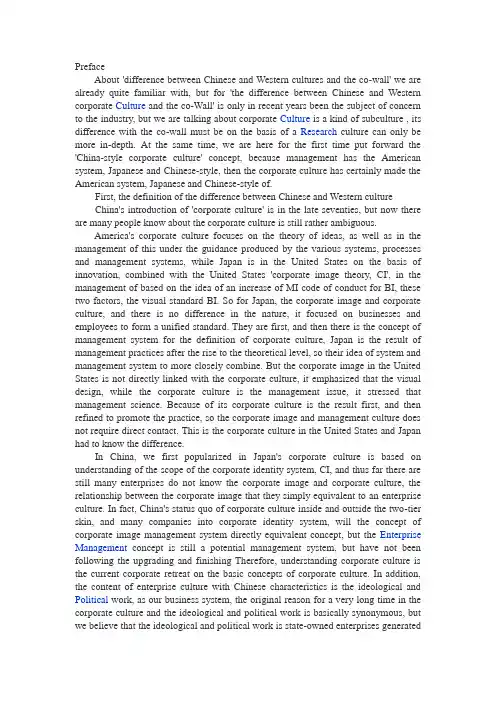
PrefaceAbout 'difference between Chinese and Western cultures and the co-wall' we are already quite familiar with, but for 'the difference between Chinese and Western corporate Culture and the co-Wall' is only in recent years been the subject of concern to the industry, but we are talking about corporate Culture is a kind of subculture , its difference with the co-wall must be on the basis of a Research culture can only be more in-depth. At the same time, we are here for the first time put forward the 'China-style corporate culture' concept, because management has the American system, Japanese and Chinese-style, then the corporate culture has certainly made the American system, Japanese and Chinese-style of.First, the definition of the difference between Chinese and Western cultureChina's introduction of 'corporate culture' is in the late seventies, but now there are many people know about the corporate culture is still rather ambiguous.America's corporate culture focuses on the theory of ideas, as well as in the management of this under the guidance produced by the various systems, processes and management systems, while Japan is in the United States on the basis of innovation, combined with the United States 'corporate image theory, CI', in the management of based on the idea of an increase of MI code of conduct for BI, these two factors, the visual standard BI. So for Japan, the corporate image and corporate culture, and there is no difference in the nature, it focused on businesses and employees to form a unified standard. They are first, and then there is the concept of management system for the definition of corporate culture, Japan is the result of management practices after the rise to the theoretical level, so their idea of system and management system to more closely combine. But the corporate image in the United States is not directly linked with the corporate culture, it emphasized that the visual design, while the corporate culture is the management issue, it stressed that management science. Because of its corporate culture is the result first, and then refined to promote the practice, so the corporate image and management culture does not require direct contact. This is the corporate culture in the United States and Japan had to know the difference.In China, we first popularized in Japan's corporate culture is based on understanding of the scope of the corporate identity system, CI, and thus far there are still many enterprises do not know the corporate image and corporate culture, the relationship between the corporate image that they simply equivalent to an enterprise culture. In fact, China's status quo of corporate culture inside and outside the two-tier skin, and many companies into corporate identity system, will the concept of corporate image management system directly equivalent concept, but the Enterprise Management concept is still a potential management system, but have not been following the upgrading and finishing Therefore, understanding corporate culture is the current corporate retreat on the basic concepts of corporate culture. In addition, the content of enterprise culture with Chinese characteristics is the ideological and Political work, as our business system, the original reason for a very long time in the corporate culture and the ideological and political work is basically synonymous, but we believe that the ideological and political work is state-owned enterprises generatedby the special context of a management culture, it's just the context of China's special part of corporate culture, rather than all the corporate culture more than Chinese culture in its entirety. We know that China's current forms of enterprises in addition to state-owned enterprises, there are foreign-funded enterprises and private enterprises, for them, the ideological and political work would not be equivalent to corporate culture. Therefore, the Chinese understanding of corporate culture is quite confusing at this stage, there are considered to be corporate image, there are considered to be ideological and political work, and even considered to be employees of the entertainment.From the above can be analyzed, the United States believes the corporate culture focused on management culture, Japan believes that the corporate culture focused on the image of culture. Chinese-style corporate culture that what should be the definition? We believe that the Chinese-style corporate culture should be 'philosophical-style corporate culture', both the philosophical and cultural. The so-called philosophy-style corporate culture refers to the corporate philosophy as the center, inside and outside the enterprise to transform a set of contradictory ways of thinking. This philosophical culture is characterized by: 'hardness with softness, dealt with gently; internally and externally within the main outer'. 'Hardness with softness, dealt with gently' management system is to rigid and flexible combination of management concepts and to management concept to guide management system, which is the management culture; 'internally and externally within the main outer' refers to the management culture and image of the culture of the times, and to guide the management culture of the image of culture. Can be seen, Chinese-style corporate culture combines the U.S. and Japanese corporate culture corporate culture advantages, while Innovation in a traditional Chinese cultural characteristics with a new model of corporate culture.Second, the difference between Chinese and Western management thinkingTalking about the differences between Chinese and Western culture, we must first understand the difference between Chinese and Western business management thinking, because differences in corporate culture is to manage the thinking behind the differences in management thinking is the core of corporate culture. The difference between Chinese and Western management thinking there are many aspects, but the most essential is the 'logic' and 'dialectical thinking,' the difference.Americans believe that logical thinking, which emphasizes the unity of the world, non-contradictory and scheduling neutral. By this way of thinking people believe that a proposition can not simultaneously right or wrong, or right, or wrong, no intermediate. Usually we say that they are 'either-or' thinking.Chinese people emphasize the dialectical thinking, which contains three principles: change theory, the contradiction theory and in theory. Change on the changing nature of departure from the world, that the world is ever changing, there is no eternal right and wrong; Contradiction believes that all things are composed of contradictions from the unity of opposites, there is no contradiction, nothing themselves, and in theory are embodied in the doctrine of the mean, that to everything there is a moderate reasonable.Third, the difference between Chinese and Western value systemDifferences in thinking in the West, under the influence of Western value systems have significant differences. Values is in us what is and what is wrong; what should and what should not be a criterion. Value system in general includes the basic values, and the value of goals, ways and restraint mechanisms to implement four aspects. We will classify and Western values, value is based on 'individualism and collectivism', the value of objective is to 'materialism and spiritualism,' implementation of the approach is' science of Marxism and the German-ism ', and restraint mechanism is' doctrine and the rule of man, the rule of law doctrine ', here we are in accordance with this classification method, the difference between Chinese and Western value systems are introduced.1, individualism and collectivismWesterners for the individual and collective thinking is focused on the collective from a personal perspective, they think that group is made up of individuals, so the focus on personal progress, emphasizes the role of individuals, ability, struggle, hard work and so on, so personal heroism is Western values is an important constituent element. As long as the opportunity to demonstrate their abilities, the Americans will be the first to fight, the champion with the record is almost an American word. And China's ways of thinking emphasize collectivism, used to analyze the individual from the collective, individual but collective in an integral part. Under the influence of such thinking, 'good deed goes unpunished, people are afraid afraid of famous pig Zhuang', 'I'm a brick, where the need to move there,' long-term guiding ideology of the Chinese people's management practices, thus forming a kind of ' a low-key, pragmatic 'cultural inclinations. Under the influence of such values, Westerners concerned about how their own view, and the Chinese people were concerned about how others look.2, materialism and spiritual doctrineFor the material needs of the West has always been considered justified, the pursuit of the interests of Social Development needs, but also a manifestation of personal values, so the values of excellence recognized by society standards. So the rich are respected in the community, there is no need for cover. The Chinese people always believe that traders 'materialistic sense' and therefore do not advocate emphasized that the material interests of promoting a cultural figures, emphasizing the pursuit of self self-cultivation is usually so as to achieve without me state, so abstinence can be said that a key feature of Chinese culture. 'Contentment''not seeking''active but they try too little wealth not only an' idea makes the development of Chinese enterprises lack a long-term ideological driving force.3, Scientism and Germany-based doctrineWestern advocates of science and reason, for the analysis things are built on a scientific, logical, analytical thinking, based on what is right what is wrong to distinguish very clearly, there is not much vague and uncertain claims on their , the 'right' is the 'right', 'wrong' is the 'wrong', it is easy to distinguish, to promote results-oriented, the sake of discussion. But the Chinese people have stressed the 'Heaven and Man', hope that, through their own internalized the value of practice to achieve the goal, 'immune', 'self-cultivation, regulating the family, ruling the state andthe world' is the representative of these values. Therefore, Chinese people are very emotional, what is 'not', 'right' is sometimes not necessarily 'wrong' is not all that is 'wrong', also in consideration of time, place, background, in particular, to pay attention to face the problem, the management thought the 'degree' difficult to grasp. However, the realm of German-based Education is too high, and even do not have much maneuverability. The Chinese concept of happiness is to some extent, ethics, and moral well-being equivalent to a.4, the rule of law doctrine and the rule of manismWestern assumptions about human nature is not the same, the West key assumptions that human nature is evil, therefore the emphasis of legal right to regulate people's behavior. They stressed that the establishment of the rule of law, all operations are based on law and therefore the relationship between people is a kind of contractual relationship, by the book value of market principles is the main trend. The Chinese culture focuses on human nature is good, so people can be enlightenment, and can be perception. The rule of man is concerned about the harmony between people, so the relationship of face for the relative legal, market, more important, do not understand the relationship between doing business in China principle is everywhere difficult, can be said that 'the door doors factions, all owned by circle '. Three cardinal guides and the formation of the five permanent members of the hierarchy of values, the concept of the will and so on.Fourth, differences between the operation of Chinese and Western culture1, Chinese and Western models of corporate culture differencesEstablished by the Western corporate culture, their business development time has been 100 years of history, management foundation is more thorough understanding of the scientific management and operational Experience of a mature, what is lacking is the management philosophy major traction, so that their corporate culture model is relatively simple, often merely to make a few core values that can be, and then under the direction of the core values, will manage the concept in the management systems and processes throughout the entire process, you can contact the practice to do philosophy, and cultural implementation of behavior.However, the current management situation of Chinese enterprises still remain in the experience of management to scientific management of the transition phase, many enterprises are relatively superficial understanding of scientific management, and more talks is not the cultural management of the stage, the corporate culture model can not be too simple, then in the primary stage of the scientific management of corporate culture can be difficult to truly reflect the system in the management of the road is only two layers of skin just inside and outside. Therefore, we believe that China's current application-oriented corporate culture corporate culture, it should be emphasized that a hierarchical model of stages to operate, we must carefully distinguish between core concepts, application ideas and dissemination of the distinction between ideas and more to the image of culture and management Cultural well together.2, the operation of Chinese and Western corporate culture differences in the wayWestern corporate culture is based on the theory of management science, so their culture is based on the Strategic Management model based on heavy content than form, although the construction of their corporate culture very much attention and investment, but few companies specifically to emphasize the work of the corporate culture or is classified into the corporate culture of their areas of work, so more of Western corporate culture is embodied in human resources, strategic management, brand marketing, among the various management systems, compare little the specialized agencies to the operation of corporate culture. But this did not reduce the corporate culture in their management system, the position or a role, with the Chinese measure of corporate culture, it should be said that their corporate culture more of a hidden and potential.China is now the corporate culture are actually remain in the exploratory stage, and not very sophisticated operation, or system of ideas. In general, more suitable for the current mode of operation should be comprehensive to promote breakthroughs in key areas, with actual situation. Comprehensively advance in the external image, internal management culture of the two systems should be comprehensive, because we are just getting started in these areas, there is no maturity model. Breakthroughs in the internal management culture, the Chinese-style management has no clear pattern can give us learn, so the management culture to talk about the stereotypes, how to find a suitable Chinese enterprises to the management of cultural patterns, this should be the Chinese-style the key to corporate culture. Actual situation is to combine the implementation of the way corporate culture take many forms, be practical, to empty, giving the false and true combined.5, Chinese and Western culture combined wallWestern corporate culture and Chinese culture have their own advantages and disadvantages, how is the Chinese-style Yangzhangbuduan the key issues shaping the corporate culture. As we have defined, Chinese-style corporate culture is a philosophy of culture, its emphasis is a dynamic equilibrium, transforming conflict, but it is definitely not without changing any of the principles is the principle under the conditions of certain changes in order to maintaining the status quo In changing to seek the same.1, philosophical and cultural connotationsAccording to the division of value system, we believe that philosophical culture, we must bear with the following aspects of the content, but we must stress that these values are not absolute contradiction between them, but a dynamic transformation, but there are certain principles of transformation, that is, who should Who is the principle of the post, or completely fell into unprincipled state.(1) the first individual and then collectivelyChina's traditional emphasis on collective rather dilute the cultural requirements of individuals, highlight the harmonious and weaken the competition, and the formation of egalitarianism, the phenomenon of eating big pot. Must therefore be based on maintaining the team spirit of individualism, empowerment doctrine, the establishment of performance management, promotion of values such as results-oriented. But it can not be simply interpreted as giving up the team spirit andstrengthen the individualism, in fact, the two are not contradictory, so individual members of the team, the team affected individuals.(2) the first material and then the spirit ofEnterprises are profitable can survive, but not just exist in order to survive. And people can not live only for money, but could not live without money. Maslow's theory tells us that people need is a stage, so we should pay attention to the material needs of employees, can not be expected only by spiritual orientation and require employees to give up the most basic requirements.(3) first and then arts and sciencesManagement is a science is art, if only the emphasis on art, it is easy to fall into the 'rule of man''Machiavellian' inside the trap and become nihilism, so that any art is science-based. Chinese-style corporate culture to emphasize the scientific basis for management to carry out art of management, strengthen basic management of construction, on the basis of rational sensibility.(4) The first system, then cultureHumans have two sides, but no matter what assumptions, business is not a religion, it does not use human beings as the ultimate goal of probation, it does not need to shoulder their social responsibility for the purpose of survival. Therefore, corporate culture should be guided by management system based on a relatively perfect system there is no management system to simply talk about the building of enterprise culture would only talk of culture, loss of institutional foundation of the corporate culture will make the cultural spirit of the building, empty of.2, China's current corporate culture and cultural factors need reinforcementAs China's integration with the international market continue to strengthen the depth and breadth of Chinese enterprises in the enterprise culture connotation, the depth and breadth of the need to constantly enhance and upgrade to meet the new market development needs, we called the corporate culture reinforcing factors.And cultural needs of Chinese enterprises reinforced main factors are:Ability doctrine: To advocate the establishment of competency-based corporate culture, dilute the 'No credit is also hard work' concepts, on this basis, foster results-oriented performance culture. At the same time to establish a level difference in pay and benefits, breaking the egalitarianism, except for eating big pot ideas. To change the Talent's 'ability and political integrity' concept to enhance the 'before' understanding of the company without violating the spirit and under the premise of social ethics, boldly newcomers to give up absolute 'loyalty' conception of qualified personnel.Open house: a positive absorption of a variety of new concepts and ideas, the introduction of different ideas, the premise of thinking in innovation management to maintain the dynamics of corporate culture to meet the development needs of the market, following the beaten track of thinking is the biggest enemy of corporate culture.Fair Competition: Although China relations-oriented culture is a major feature of traditional culture, but in an increasingly strong sense of market circumstances, the fair competition is the development trend of the market, so how to enhance businessawareness and market competition, enterprises need the ability enhanced ideology.Professional spirit: Chinese enterprises must strive to strengthen the professionalism of staff training to teach employees how to become a market economy under the conditions of a qualified professional staff, improve work efficiency, enhance professional responsibility.System Management: In the absence of a good system management infrastructure, stressed the role of the corporate culture of Marxism and nihilism easy rule of man-oriented corporate culture is based on the scientific management system.。
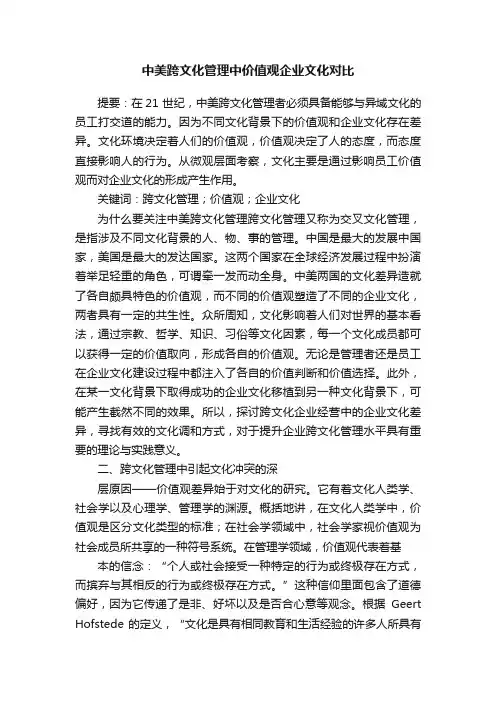
中美跨文化管理中价值观企业文化对比提要:在21 世纪,中美跨文化管理者必须具备能够与异域文化的员工打交道的能力。
因为不同文化背景下的价值观和企业文化存在差异。
文化环境决定着人们的价值观,价值观决定了人的态度,而态度直接影响人的行为。
从微观层面考察,文化主要是通过影响员工价值观而对企业文化的形成产生作用。
关键词:跨文化管理;价值观;企业文化为什么要关注中美跨文化管理跨文化管理又称为交叉文化管理,是指涉及不同文化背景的人、物、事的管理。
中国是最大的发展中国家,美国是最大的发达国家。
这两个国家在全球经济发展过程中扮演着举足轻重的角色,可谓牵一发而动全身。
中美两国的文化差异造就了各自颇具特色的价值观,而不同的价值观塑造了不同的企业文化,两者具有一定的共生性。
众所周知,文化影响着人们对世界的基本看法,通过宗教、哲学、知识、习俗等文化因素,每一个文化成员都可以获得一定的价值取向,形成各自的价值观。
无论是管理者还是员工在企业文化建设过程中都注入了各自的价值判断和价值选择。
此外,在某一文化背景下取得成功的企业文化移植到另一种文化背景下,可能产生截然不同的效果。
所以,探讨跨文化企业经营中的企业文化差异,寻找有效的文化调和方式,对于提升企业跨文化管理水平具有重要的理论与实践意义。
二、跨文化管理中引起文化冲突的深层原因——价值观差异始于对文化的研究。
它有着文化人类学、社会学以及心理学、管理学的渊源。
概括地讲,在文化人类学中,价值观是区分文化类型的标准;在社会学领域中,社会学家视价值观为社会成员所共享的一种符号系统。
在管理学领域,价值观代表着基本的信念:“个人或社会接受一种特定的行为或终极存在方式,而摈弃与其相反的行为或终极存在方式。
”这种信仰里面包含了道德偏好,因为它传递了是非、好坏以及是否合心意等观念。
根据Geert Hofstede 的定义,“文化是具有相同教育和生活经验的许多人所具有的理程序”。
每一种文化都体现出其民族特定的思维和行为方式。

美国和中国的企业文化有何区别?随着全球化的发展,越来越多的企业跨越国界进行业务,企业文化的差异也成为了企业管理中不可忽视的因素。
美国和中国作为世界上最大的两个经济体,两者的企业文化自然也存在着显著的差异。
下面将从几个方面进行解析。
1.文化背景美国是一个多元化的移民国家,其社会文化背景非常独特。
在这个国家中,人们尊重个人和个人的自由、权利,崇尚竞争、勇气和探索精神。
因此,在美国企业中,管理者注重员工的自由和创造性的发挥,在企业中鼓励竞争和激励,鼓励员工团队合作,追求利润最大化。
相比之下,中国拥有深厚的传统文化背景,注重伦理道德、亲情友情等人文关怀。
在中国企业中,尊重家族、社会等群体的权威,强调员工的稳定性和稳定性的发展,在企业中偏向于注重“和谐稳定”和共同发展。
2.管理风格在美国企业中,管理风格比较开放、灵活和民主。
管理者和员工之间的关系相对平等,管理者往往是用人才、发展人才的人,鼓励员工的独立和创造性。
因此,美国企业中的员工往往有很高的自由度和主动性。
相对地,在中国企业中,员工往往受到更多的监管和控制,缺乏足够的独立性和主动性,为了保持企业和谐稳定,管理者往往采取强硬的管理方式,以保证员工的执行力和领导力。
3.组织结构在美国企业中,组织结构比较扁平化、简单和灵活,这有助于传递信息和快速决策。
美国企业往往采用分权的管理模式,鼓励各个部门之间的合作,并保留了一定的自主权。
而在中国企业中,组织结构通常比较复杂、层级较多,存在较多的官僚主义倾向。
管理者之间的问责和沟通渠道较为混乱,往往需要经过多重程序。
因此,在组织规划、决策和执行方面,中国企业显得更为缓慢而不灵活。
4.精神价值在美国企业文化中,重视“西方价值观”,也就是普遍的个人主义、竞争和如果这对企业利益产生便利,个人目标或意识将被强制性欣赏。
这反映在在美国中企业经营方式及其洛杉矶美容院开业经验等等方面,在企业经营中普遍重视经济效益,以企业的增长和利润为目标。
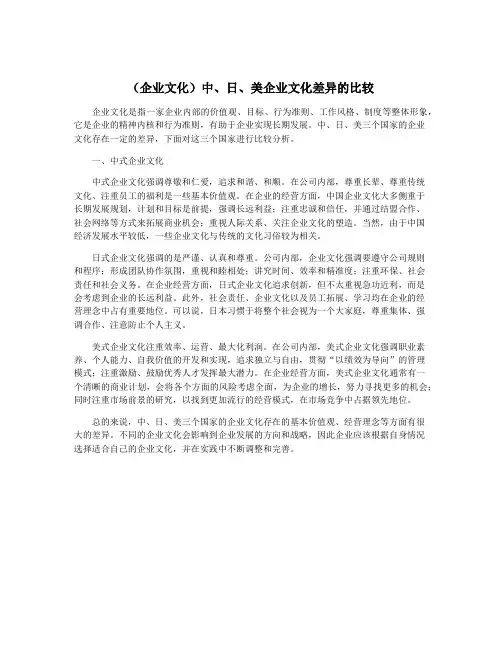
(企业文化)中、日、美企业文化差异的比较企业文化是指一家企业内部的价值观、目标、行为准则、工作风格、制度等整体形象,它是企业的精神内核和行为准则,有助于企业实现长期发展。
中、日、美三个国家的企业文化存在一定的差异,下面对这三个国家进行比较分析。
一、中式企业文化中式企业文化强调尊敬和仁爱,追求和谐、和顺。
在公司内部,尊重长辈、尊重传统文化、注重员工的福利是一些基本价值观。
在企业的经营方面,中国企业文化大多侧重于长期发展规划,计划和目标是前提,强调长远利益;注重忠诚和信任,并通过结盟合作、社会网络等方式来拓展商业机会;重视人际关系、关注企业文化的塑造。
当然,由于中国经济发展水平较低,一些企业文化与传统的文化习俗较为相关。
日式企业文化强调的是严谨、认真和尊重。
公司内部,企业文化强调要遵守公司规则和程序;形成团队协作氛围,重视和睦相处;讲究时间、效率和精准度;注重环保、社会责任和社会义务。
在企业经营方面,日式企业文化追求创新,但不太重视急功近利,而是会考虑到企业的长远利益。
此外,社会责任、企业文化以及员工拓展、学习均在企业的经营理念中占有重要地位。
可以说,日本习惯于将整个社会视为一个大家庭,尊重集体、强调合作、注意防止个人主义。
美式企业文化注重效率、运营、最大化利润。
在公司内部,美式企业文化强调职业素养、个人能力、自我价值的开发和实现,追求独立与自由,贯彻“以绩效为导向”的管理模式;注重激励、鼓励优秀人才发挥最大潜力。
在企业经营方面,美式企业文化通常有一个清晰的商业计划,会将各个方面的风险考虑全面,为企业的增长,努力寻找更多的机会;同时注重市场前景的研究,以找到更加流行的经营模式,在市场竞争中占据领先地位。
总的来说,中、日、美三个国家的企业文化存在的基本价值观、经营理念等方面有很大的差异。
不同的企业文化会影响到企业发展的方向和战略,因此企业应该根据自身情况选择适合自己的企业文化,并在实践中不断调整和完善。
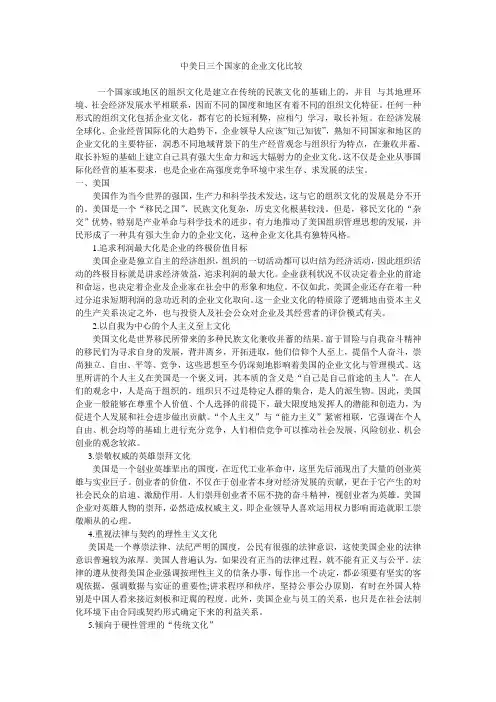
中美日三个国家的企业文化比较一个国家或地区的组织文化是建立在传统的民族文化的基础上的,并目_与其地理环境、社会经济发展水平相联系,因而不同的国度和地区有着不同的组织文化特征。
任何一种形式的组织文化包括企业文化,都有它的长短利弊,应相勺_学习,取长补短。
在经济发展全球化、企业经营国际化的大趋势下,企业领导人应该“知己知彼”,熟知不同国家和地区的企业文化的主要特征,洞悉不同地域背景下的生产经营观念与组织行为特点,在兼收并蓄、取长补短的基础上建立自己具有强大生命力和远大辐射力的企业文化。
这不仅是企业从事国际化经营的基本要求,也是企业在高强度竞争环境中求生存、求发展的法宝。
一、美国美国作为当今世界的强国,生产力和科学技术发达,这与它的组织文化的发展是分不开的。
美国是一个“移民之国”,民族文化复杂,历史文化根基较浅。
但是,移民文化的“杂交”优势,特别是产业革命与科学技术的进步,有力地推动了美国组织管理思想的发展,并民形成了一种具有强大生命力的企业文化,这种企业文化具有独特风格。
1.追求利润最大化是企业的终极价值目标美国企业是独立自主的经济组织,组织的一切活动都可以归结为经济活动,因此组织活动的终极目标就是讲求经济效益,追求利润的最大化。
企业获利状况不仅决定着企业的前途和命运,也决定着企业及企业家在社会中的形象和地位。
不仅如此,美国企业还存在着一种过分追求短期利润的急功近利的企业文化取向。
这一企业文化的特质除了逻辑地由资本主义的生产关系决定之外,也与投资人及社会公众对企业及其经营者的评价模式有关。
2.以自我为中心的个人主义至上文化美国文化是世界移民所带来的多种民族文化兼收并蓄的结果。
富于冒险与自我奋斗精神的移民们为寻求自身的发展,背井离乡,开拓进取,他们信仰个人至上,提倡个人奋斗,崇尚独立、自由、平等、竞争,这些思想至今仍深刻地影响着美国的企业文化与管理模式。
这里所讲的个人主义在美国是一个褒义词,其本质的含义是“自己是自己前途的主人”。
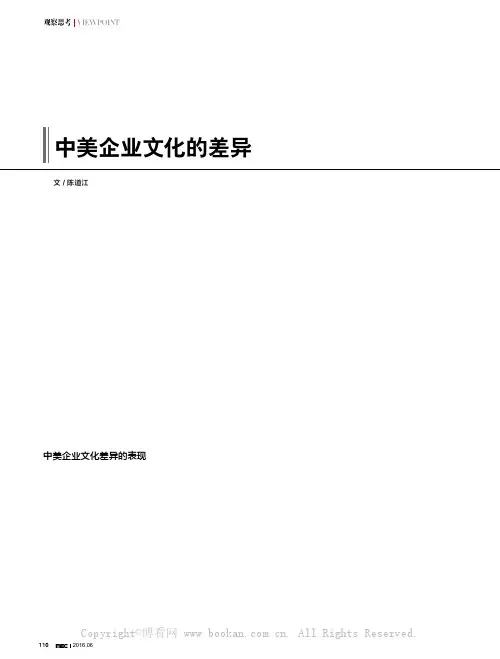
1102016.06企业文化理论形成于美国,是美国的管理学家针对日本企业对美国经济的挑战,研究和总结日本企业管理经验提出的理论。
这一理论创立之初,即被誉为“静悄悄的企业革命”和“现代管理的成功之道”,并在美国企业界广泛运用。
我国的企业特别是国有企业文化形成也经历了长期的发展过程,具备了自身的特色,但与美国的先进企业相比,企业文化建设仍然存在差距和不足。
因此,立足于中美企业所处的大背景即国家文化的差异,对比中美企业文化在企业管理中的不同表现,总结提炼美国企业文化对我国企业发展的借鉴意义,在当前具有十分重要的意义和价值。
中美企业文化差异的表现不同中美文化背景带来的思维方式、沟通方式、法制观念、领导方式上的差异,在企业管理中主要表现在以下方面:管理模式。
美国的市场经济受美国文化背景和价值观念的影响,表现出与其他资本主义国家市场经济不同的方面。
基于价值取向的不同,美国的市场经济被称为个人资本主义。
而中国正处于由传统的计划经济向社会主义市场经济的转型过程中,广泛学习各种先进的管理方式方法,形成有中国特色的社会主义市场经济。
在中美合资企业中,面临管理模式困扰,或由于管理者忽视文化摩擦,而使得跨国公司全球战略遇到障碍。
某一决策在理论上无可挑剔,在实施中却遇到重重阻碍;同一决策,在甲地贯彻实施效果颇佳,在乙地却未必得心应手。
文化造成的摩擦难以通过产品多样化、组织结构复杂化等经营策略来克服,文化造成的偏差只能通过调整文化来纠正。
美国微软公司在管理中对每一个员工灌输正确对待失败、尊重失败的思想,甚至提出“没有失败说明工作没有努力”。
正因为失败成就了微软一次次令对手胆寒的成功。
用微软自己的话说:“失败是成功的一种需要。
”微软公司还大力倡导“释放信息”“工作任意小时”“不需要再开一次会”等管理理念。
这些管理经验和模式非常值得中国国有企业学习和借鉴。
组织结构。
企业组织设计中的文化因素影响,主要体现在两个方面:一是明确个人在组织中的地位和作用,保持一定的权力距离。
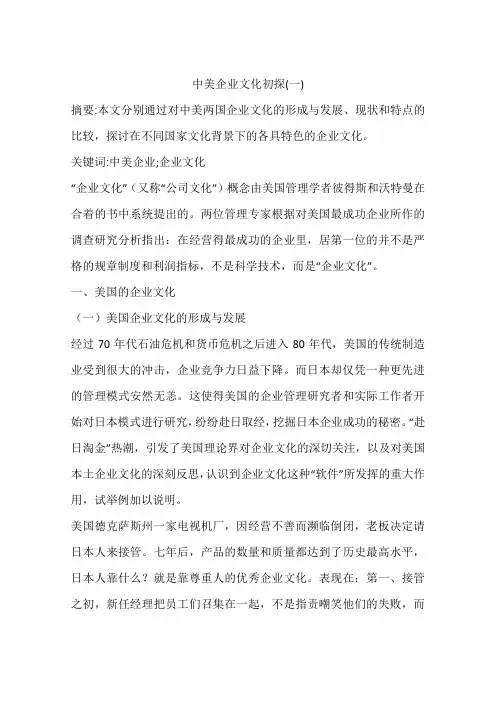
中美企业文化初探(一)摘要:本文分别通过对中美两国企业文化的形成与发展、现状和特点的比较,探讨在不同国家文化背景下的各具特色的企业文化。
关键词:中美企业;企业文化“企业文化”(又称“公司文化”)概念由美国管理学者彼得斯和沃特曼在合着的书中系统提出的。
两位管理专家根据对美国最成功企业所作的调查研究分析指出:在经营得最成功的企业里,居第一位的并不是严格的规章制度和利润指标,不是科学技术,而是“企业文化”。
一、美国的企业文化(一)美国企业文化的形成与发展经过70年代石油危机和货币危机之后进入80年代,美国的传统制造业受到很大的冲击,企业竞争力日益下降。
而日本却仅凭一种更先进的管理模式安然无恙。
这使得美国的企业管理研究者和实际工作者开始对日本模式进行研究,纷纷赴日取经,挖掘日本企业成功的秘密。
“赴日淘金”热潮,引发了美国理论界对企业文化的深切关注,以及对美国本土企业文化的深刻反思,认识到企业文化这种“软件”所发挥的重大作用,试举例加以说明。
美国德克萨斯州一家电视机厂,因经营不善而濒临倒闭,老板决定请日本人来接管。
七年后,产品的数量和质量都达到了历史最高水平,日本人靠什么?就是靠尊重人的优秀企业文化。
表现在:第一、接管之初,新任经理把员工们召集在一起,不是指责嘲笑他们的失败,而是请他们喝咖啡聚会,向每位员工赠送一台半导体收音机。
第二、日本经理主动地拜会工会负责人,希望“多多关照”,力图使美国工人解除心理戒备,在感情上与日本人靠拢。
第三、工厂生产有了起色以后,日本经理把以前被该厂解雇的老职工全部找回去重新任用,以培育工人们的“报恩之心”。
20世纪80年代以后,美国的企业形成了符合企业经营哲学和经营战略的企业文化。
(二)美国企业文化现状美国是一个移民国家,文化根基浅,僵化的传统不多,全社会都重视突出个人的作用。
这种文化在企业里,首先表现为尊重个人的尊严和价值,以及对员工的充分信任。
“品质第一,顾客至上”也是构成美国企业文化的重要组成部分。
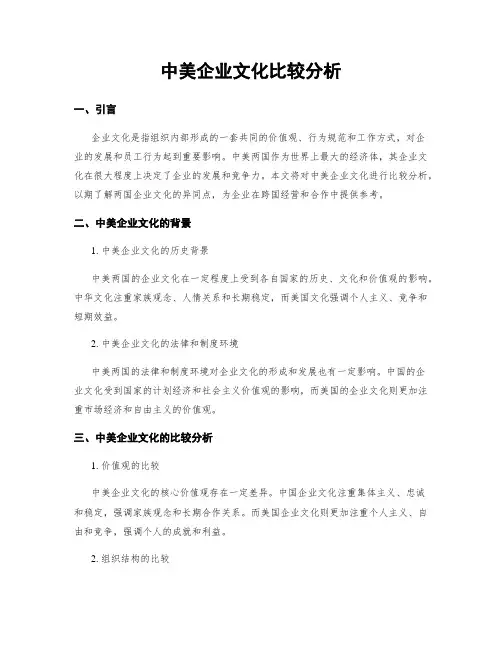
中美企业文化比较分析一、引言企业文化是指组织内部形成的一套共同的价值观、行为规范和工作方式,对企业的发展和员工行为起到重要影响。
中美两国作为世界上最大的经济体,其企业文化在很大程度上决定了企业的发展和竞争力。
本文将对中美企业文化进行比较分析,以期了解两国企业文化的异同点,为企业在跨国经营和合作中提供参考。
二、中美企业文化的背景1. 中美企业文化的历史背景中美两国的企业文化在一定程度上受到各自国家的历史、文化和价值观的影响。
中华文化注重家族观念、人情关系和长期稳定,而美国文化强调个人主义、竞争和短期效益。
2. 中美企业文化的法律和制度环境中美两国的法律和制度环境对企业文化的形成和发展也有一定影响。
中国的企业文化受到国家的计划经济和社会主义价值观的影响,而美国的企业文化则更加注重市场经济和自由主义的价值观。
三、中美企业文化的比较分析1. 价值观的比较中美企业文化的核心价值观存在一定差异。
中国企业文化注重集体主义、忠诚和稳定,强调家族观念和长期合作关系。
而美国企业文化则更加注重个人主义、自由和竞争,强调个人的成就和利益。
2. 组织结构的比较中美企业的组织结构也存在差异。
中国企业通常采用较为集中的权力结构,决策权集中在高层管理人员手中,强调领导者的权威和决策。
而美国企业则更加注重分权和平等,倡导员工参与决策和发挥创造力。
3. 沟通方式的比较中美企业在沟通方式上也有所不同。
中国企业通常采用间接和非言语的沟通方式,注重人际关系和面子问题。
而美国企业则更加注重直接和开放的沟通方式,强调解决问题和达成共识。
4. 奖惩机制的比较中美企业的奖惩机制也存在差异。
中国企业通常采用隐性奖惩机制,强调团队合作和集体利益。
而美国企业则更加注重明确的奖惩制度,强调个人的绩效和成就。
5. 员工关系的比较中美企业的员工关系也有所不同。
中国企业注重长期稳定的雇佣关系,强调员工的忠诚和归属感。
而美国企业则更加注重灵活的雇佣关系,强调员工的能力和成果。
中美企业文化初探1. 引言中美企业文化是指在中国和美国的企业中所形成的一种特定的文化氛围和价值观体系。
由于中美两国的文化差异,企业文化在两国之间存在一些明显的差异。
本文将对中美企业文化进行初步探讨,分析两国企业文化的主要特点和差异。
2. 中美企业文化的主要特点2.1 中企业文化特点中国企业文化注重集体主义和家族观念。
中国传统文化中强调尊重家长、长辈和领导,这一价值观也体现在企业文化中。
此外,中国企业文化还强调稳定性和传统价值观,例如对文化传承、孝道、忠诚度等的重视。
2.2 美企业文化特点美国企业文化注重个人主义和创新。
美国文化中强调个人权利、自由和个人成就,美国企业文化中也体现了这种价值观。
此外,美国企业文化还重视创新和灵活性,推崇勇于冒险和创造性思维。
3. 中美企业文化的差异3.1 价值观差异中美企业文化在价值观方面存在明显差异。
中企业文化注重家族观念和尊重长辈的传统价值观,强调忠诚度和稳定性。
而美国企业文化注重个人主义和自由的传统价值观,强调个人能力和追求个人成就。
3.2 组织结构差异中美企业在组织结构上也存在差异。
中国企业通常采用更为集中的组织结构,权力和决策集中在高层管理层。
而美国企业通常采用更为分散的组织结构,更加注重员工的自主性和创造力。
3.3 沟通方式差异中美企业在沟通方式上也有所不同。
中国企业更注重面对面的沟通,强调直接和真实的交流。
而美国企业更注重书面沟通和电子沟通,更加强调清晰和明确的表达。
4. 中美企业文化的共同点除了差异之外,中美企业文化也有一些共同的特点。
首先,中美企业文化都强调业绩和结果导向。
无论是中国企业还是美国企业,在追求商业成功和实现经济目标方面都非常重视。
其次,中美企业文化都注重团队合作。
虽然在价值观和组织结构上存在差异,但中美企业都认识到团队的价值,注重在团队合作中实现协同效应。
此外,中美企业文化都面临着全球化的挑战。
随着全球化的深入发展,中美企业不仅需要应对本国国内市场的竞争,还需要面对来自全球竞争对手的挑战。
中美日三国企业文化之异同第一篇:中美日三国企业文化之异同中美日三国企业文化之异同摘要:企业文化——是企业在经营实践过程中,由企业管理者倡导的,在大部分员工中逐渐形成的共同的价值观念、行为模式、感觉氛围、企业形象的总和。
本文通过对中美日三国企业文化的对比来分析对中国企业文化建设的启示。
关键词:企业文化中国企业文化美国企业文化日本企业文化启示一、企业文化的内涵企业文化——是企业在经营实践过程中,由企业管理者倡导的,在大部分员工中逐渐形成的共同的价值观念、行为模式、感觉氛围、企业形象的总和。
企业文化的建设需要满足与战略系统相匹配的要求和与组织能力系统相匹配的要求。
在这个定义中,企业文化包含了四个层面的内涵:1、共同的价值观念——是企业决策者主导和倡导的,支撑企业发展的使命、宗旨、核心价值观、战略愿景等一系列价值观念、价值主张。
2、共同的行为模式——共同的行为模式包括由共同的行为意识、行为能力、行为实践构成的行为习惯和相应的行为结果。
3、共同的感觉氛围——组织群体共同的心理契约,形成了大家习惯的感觉氛围,这个氛围也是我们通常讲到的文化氛围。
4、外在的企业形象——企业形象是外部利益相关者对企业的感受和认识。
企业文化是在生产经营和管理过程中所创建的具有本企业特色的物质财富和精神财富的总和。
它包括企业制度、组织机构、企业环境、企业产品、企业精神、道德规范、价值观念等等。
价值观念是企业文化的核心。
它的产生有深刻的经济和社会根源。
企业文化至少分为核心层和外围层。
核心层是指企业的经营理念和价值观念。
企业文化的外围层是企业员工的行为模式。
企业文化在企业起着至关重要的作用,它影响着企业中的每一件事,大至企业决策、人事任命、干部选拔,小至员工的行为举止、衣着爱好;它影响着企业的每时每刻,早至创立之初如何开展业务扩大规模,中至如何维持优势二次创业,后至走向衰退或者基业长青。
具体地说,企业文化的作用有以下五个方面:1、具有企业灵魂的导向作用2、具有团队精神建设的凝聚作用3、具有实现企业振兴的激励作用4、具有行为规范内在的约束作用5、具有企业形象美化的辐射作用二、中国企业管理特色中国企业的发展已经历了百余年。
中美企业文化比较分析 一、引言 企业文化是指企业内部形成的一种价值观念、行为规范和组织氛围,它对企业的发展和运营起着重要的影响。中美两国是世界上最大的经济体,其企业文化在全球范围内具有重要影响力。本文将对中美企业文化进行比较分析,以探讨两国企业文化的异同点。
二、背景介绍 1. 中美企业文化的定义和特点 - 中美企业文化的定义:中美企业文化是指在中美两国企业内部形成的一系列共同的价值观念、行为规范和组织氛围。
- 中美企业文化的特点:中美企业文化在一定程度上反映了两国的历史、文化、价值观念等差异,同时也受到全球化和经济发展的影响。
2. 中美企业文化比较的意义 - 了解中美企业文化的异同点,有助于企业在跨国经营中更好地适应当地文化环境,提高企业的竞争力。
- 通过比较分析,可以借鉴两国企业文化的优点,促进中美企业之间的合作与交流。
三、中美企业文化比较分析 1. 价值观念比较 - 中美企业的价值观念差异:中美企业的价值观念在一定程度上反映了两国的历史、文化和社会背景。中美企业的价值观念差异主要体现在对个人与集体的关系、对权力和权威的认同、对利益追求的态度等方面。
- 中美企业的价值观念相似之处:尽管存在差异,但中美企业的价值观念也存在一些相似之处。比如,对于诚信、创新、质量等方面的重视,在中美企业文化中都占有重要地位。
2. 行为规范比较 - 中美企业的行为规范差异:中美企业的行为规范在一定程度上受到国家法律法规、社会习惯等因素的影响。中美企业的行为规范差异主要体现在工作时间、工作方式、沟通方式等方面。
- 中美企业的行为规范相似之处:尽管存在差异,但中美企业的行为规范也存在一些相似之处。比如,对于团队合作、高效执行等方面的要求,在中美企业文化中都占有重要地位。
3. 组织氛围比较 - 中美企业的组织氛围差异:中美企业的组织氛围在一定程度上反映了两国的文化传统和管理理念。中美企业的组织氛围差异主要体现在权力分配、决策方式、员工关系等方面。
155高等教育企业文化是一个企业的综合性财富,其包含了道德规范、经营理念、行为准则、企业精神等,正确的价值观可促进企业的发展,当前全球化的趋势已经不可逆转,中美作为世界经济总量前两名的大国,应紧密联系,相互学习,并借鉴优秀的企业管理文化,促进其经济发展。
一、中美传统文化的差异中国的传统文化起源于儒家思想,而中国文化的发展又是朝向重实用、重道德、重群体的,与此同时,维系人与人之间关系的理论是以宗法血缘为根基。
重人文教养与理性;重稳定、追求实际;重统一与和谐;重伦理,道德至上等构成了我国的传统文化,其文化中主张“真善美”,即自然和谐为真;人际和谐为善;天人和谐为美。
而美国文化则来源于基督与古希腊文化,该文化极力主张个人主义与自主性的体验,在发展过程中,逐渐养成了重思辨、重科学、重个体的特点,并形成了市民社会文化与商业社会文化,其都以平民为主体,都充分体现出了民主与平等的社会发展模式。
因此,两种不同的文化系统有着巨大的差异,而通过传统文化衍生而来的企业文化也会有着较大的差异,一个国家的企业文化通常是该社会文化与民族文化的真实反映,因而东西方的企业管理文化也具备着极大的研究价值。
二、中美工商企业管理文化的对比研究(一)在决策方式上中美两国的工商企业在决策方式上存在一定的差异,思维模式与决策的差异主要体现在中国的企业文化在程序化或计划性方面意识不强,但企业的灵活性与适应性极强,在企业的决策过程中,通常都以情为重,该方式在灵活的同时,往往会忽略条例管理或制度方面的问题,无疑会削弱制度的执行力度,“人治”的观念较为强烈,导致无论是惩罚还是奖赏,都显得弹性度较大[1]。
而美国的企业文化则是理性主义,通常强调逻辑与原则,并以制度作为企业立根的基础,维系员工与企业的主要依靠契约,而非情感。
在正常的企业处事或决策时原则性极强,对秩序及规则很是尊重。
由于该制度往往依赖于多个规章制度,因而其较强的控制性在一定程度上制约了某些企业的发展,并没有完全发挥出企业成员的潜力,降低了企业的工作效率。
中、美、日企业文化比较分析第一篇:中、美、日企业文化比较分析中、美、日企业文化比较分析地域差异带来的不仅仅会带来不同的语言、不同的饮食习惯,更深层次的,由于社会文化的不同,企业文化也存在着巨大的差异。
本人在对相关专家对中、美、日三国间企业文化的研究成果消化吸收后,也提出了自己的一些看法,在此与大家共分享。
首先,让我们先从美国的企业文化讲起,其特点主要体现在以下几方面:(一)突出个人能力,尊重个人价值美国的企业文化着眼于个人,鼓励个人努力奋斗,突出个人能力;企业内部充满自由平等精神,个人充分发表自己的意见;革新和实验受到鼓励;人们乐于求新求变,乐于开拓冒险;强调个人负责,个人决策。
根据个人完成任务,尽责尽职情况,给予个人奖励。
这些突出个人能力智慧的企业文化,有效的调动人的积极性,激励了人们的竞争、创新和冒险精神,减少了人际摩擦和能量内耗。
但不利的一面就是,其易于削弱集体力量,影响相互合作,使人们更多地将企业看作是个人赚钱和实现抱负的场所,缺乏献身企业的归属感和集体荣誉感。
(二)重视理性的行为方式具体表现为:1.求实精神较强,形式主义较少。
企业内部人际关系讲求实在,较少虚假,沟通意见直接明确。
企业质量小组(QC)就信奉"爱怎么干就怎么干,只要干得有意义,有效果就好"。
企业有较强的行动意识,既重言,更重实,乐于实干。
2.提倡科学与合理。
重视组织机构和规章制度的作用。
比较重视硬性管理。
企业对系统论、信息论、控制论和各种定量方法,计算机的广泛使用。
人们在经营管理过程,尊重科学,依章办事,追求合理,较少受人情关系的影响。
3.强调企业与员工之间的契约关系。
从实际需要出发,招聘或解雇工人完全靠合同契约维系员工之间的关系,较少考虑情面关系。
这样做,虽有利提高效率,但影响劳资关系。
由于只重理性,不重感情,企业内部等级较严,刚性过份,柔性不足,往往压抑人的情感和创造力。
近年一些企业已开始改变对员工行为的控制。
强调"独立自主","感情投资"、"协商沟通"、"大众参与"、"职务扩大化"、"弹性工作日"、"动式管理"等,来实现硬管理与软管理的结合,发挥员工各自优势。
中美企业文化浅探引言企业文化是指企业内部的一种价值观、行为规范和信仰体系,它的形成和发展受到国家和地区的文化环境的影响。
中美两国作为世界上最大的经济体之一,其企业文化有着明显的差异。
本文将以中美企业文化为研究对象,浅探二者在价值观、沟通方式、决策方式和工作态度等方面的差异。
一、价值观的差异中美企业文化中最为显著的差异之一就是价值观的差异。
中美企业的价值观体现了两国社会背景和文化传统的不同。
在中美企业中,价值观的差异主要体现在以下几个方面:1.1 个人主义 vs. 集体主义在美国企业文化中,个人主义是核心价值观之一。
美国人重视个人的独立性、自由和竞争意识。
在美国企业中,个人的成就和个人的权利被重视并且受到认可。
而在中国企业文化中,集体主义是核心价值观之一。
中国人注重集体的利益,并倾向于在团队中工作和合作。
1.2 风险与创新美国企业文化鼓励创新和冒险。
美国人习惯于面对风险,尝试新的想法和方法。
他们对失败有更高的容忍度,相信失败是成功的一部分。
相比之下,中国企业文化更为保守。
中国人更喜欢稳定和可预测的发展路径,并且对创新和冒险持更加保守的态度。
二、沟通方式的差异沟通是企业文化中的核心要素之一,中美企业在沟通方式上也存在一些差异。
2.1 直接沟通 vs. 间接沟通美国企业文化偏向于直接沟通。
美国人注重直言不讳,他们习惯于直接表达自己的意见和观点。
而中国企业文化中,间接沟通被更多地采用。
中国人更喜欢使用隐晦的措辞和非言语方式来传递信息,以免伤害他人的面子。
2.2 面对面沟通 vs. 网络沟通在美国企业文化中,面对面的沟通被认为是最有效的沟通方式。
美国人注重面对面的交流和沟通,重视面部表情和非言语传达的信息。
而在中国企业文化中,随着网络技术的发展,越来越多的沟通方式转向了网络沟通,如电子邮件、即时通讯工具等。
三、决策方式的差异决策方式是企业文化中的关键要素之一,中美两国企业在决策方式上存在一定的差异。
3.1 集中决策 vs. 分散决策在美国企业文化中,决策往往是由少数高级管理人员做出的。
中美企业文化比较研究目录摘要 (2)Abstract (2)1、前言 (3)2、企业文化的内涵 (3)2.1 文化的含义、企业文化的含义 (3)2.2 企业文化的核心、内容、功能和特点 (4)3、中美企业文化的形成与发展 (4)3.1 中国企业文化的形成与发展 (4)3.2 美国企业文化的形成与发展 (5)4、中美企业文化比较分析 (7)4.1 宏观层面的中美企业文化差异 (7)4.2 企业层面的中美企业文化差异 (8)4.3 个体层面的中美企业文化差异 (9)5、中美两国企业文化优缺点评析 (10)5.1 中国企业文化优缺点评析 (10)5.2 美国企业文化优缺点评析 (10)6、对中国企业发展先进企业文化的启示 (11)参考文献 (12)中美企业文化比较研究摘要每个国家的企业文化都有其各自的特点,中美两国也不例外。
研究中美两国企业文化间的差异,使中国企业更加清醒的认识到自身的优缺点。
探讨如何学习借鉴外国先进的企业文化,使中国企业在塑造独具特色的企业文化的过程中,获得一些有益的启示,具有十分重要的意义。
本论文重点论述了中美企业文化各自是如何形成的,它们有着怎样的历史渊源;中美企业文化的特点具体有哪些,它们又有着怎样的优缺点;以及中国企业应该如何取长补短,学习借鉴其他国家的先进企业文化。
关键词:中国企业、美国企业、企业文化AbstractEach country has its own enterprise culture characteristics including China and the United States. Research in the differences between the enterprise culture of China and the United States may help Chinese enterprises awaring more of the advantages and disadvantages. It has a extremely vital significance in discussing how to learn from foreign advanced enterprise culture to get some beneficial enlightenment in the process of shaping of the unique culture. This paper mainly discusses how the enterprise culture formed, what the history origin they have; and how the Chinese enterprises should be learn more from other advanced enterprise culture to perfect themselves.Key words:Chinese Enterprises 、American Enterprises、Corporate Culture1、前言每个国家的企业文化都有其各自的特点,中美两国也不例外。
由于社会制度、传统文化、历史经历、地理位置和经济水平等诸多因素的共同影响,使得中美两国企业文化呈现出迥然不同的特色。
分析中美两国企业文化差异的各个方面,并在此基础上为中国企业文化的发展提出相应的建议是非常有必要的。
然而对中美两国企业文化的特点作对比分析,早已不是什么新鲜的话题,前人已经进行过大量深入细致的研究。
但在查阅众多的文献资料后,笔者发现,前人的研究成果丰富而庞杂,一篇论文中常常只总结了几条研究成果,通常不会超过五六条,且涉及的层面广泛、领域交错,并没有按照一定的标准进行系统的归类。
其次,有些文献在论述过程中,语气上带有明显地意识形态意味,刻意地褒中贬美,进行一些超过学术范围的宣传。
而另外一些文献为了突出中国企业在文化建设中存在的问题,又刻意的褒美贬中,强调中国企业应该如何地向美国企业学习。
不管出于何种目的,这种有失偏颇地研究与论述过程都是不可取。
笔者认为,对于中美两国企业文化的特点,我们应该进行系统的归类,并以简洁明了的方式展示出来。
对于中美两国企业文化的优缺点,我们也应该进行中肯的表述,这样才能认清彼此,以利相互学习,共同进步。
那么,中美企业文化各自是如何形成的,它们有着怎样的历史渊源?中美企业文化的特点具体有哪些?它们又有着怎样的优缺点?中国企业应该如何取长补短,学习借鉴其他国家的先进企业文化呢?怀揣着这些疑问,本着求真务实的态度,笔者开始了实事求是的研究。
2、企业文化的内涵2.1 文化的含义、企业文化的含义文化是一个复合体,包含一个国家或民族的历史地理、风土人情、传统习俗、生活方式、文学艺术、行为规范、思维方式、价值观念等,它使得一个群体有着区别于另一群体的显著特征。
文化作为人类知识信仰、文学艺术、宗教哲学、伦理法律和风俗习惯等精神财富的复合体,时刻都在影响着人们的言行举止以及生活工作方式。
企业文化是企业长期生产、经营、建设、发展过程中所形成的管理思想、管理方式、管理理论、群体意识以及与之相适应的思维方式和行为规范的总和。
它是企业意识形态、物质形态、制度形态等精神文化的复合体;是外显于厂风厂貌、内显于员工心灵中的以价值观为核心的意识形态;是一个企业在自身发展过程中形成的独特管理模式;是一种凝聚人心以实现自我价值、提升企业竞争力的无形力量。
2.2 企业文化的核心、内容、功能和特点企业文化的核心是企业员工的价值观,它决定着员工的思维方式和行为方式。
企业文化的主要内容是企业价值观、经营哲学、企业精神、企业道德、团队意识、企业形象、企业制度、企业使命和企业员工共同遵守的道德行为规范等。
企业文化的功能就是要使其成为增强企业内部凝聚力和适应外界环境变化的能力。
企业文化对企业的发展看起来不是最直接的因素,但却是最显著、最持久的决定性因素。
企业文化作为组织共同遵守的价值观念和行为准则,影响着产品的创意、设计、生产、运输、营销和售后等各个方面,从而最终影响企业的综合竞争力。
优秀的企业文化一般具备以下几个基本特点:(1)能得到员工的广泛认同;(2)能在价值观指导下成功的实践与验证;(3)能使员工产生使命感;(4)能使员工对企业产生深厚的感情;(5)能使企业产生不可复制的竞争力。
3、中美企业文化的形成与发展文化虽然相对于其他社会现象比较稳定,但其本身也是一个动态发展的过程,企业文化也不例外。
众所周知,中华文明起源于黄河流域,三面陆地一面靠海的地理环境使中华文化保持很强的稳定性和历史延续性。
这种独特的自然环境造就了中华民族独有的文化传统、社会心理以及内倾型人格。
与此截然不同的是,东西两大洋,南北无强敌的地理位置,使得美国文化明显带有西方文明所共有的开放性,并形成了自己独有地兼容性和进取性很强的多元文化,就像一个文化大熔炉。
以各自文化生成所依赖的地理环境差异为依据,我们可以把中美两国文化分别归结为内陆型文化和海洋型文化。
正是由于中美两国文明建立在各自自成系统的文化背景上,才使得各自的企业文化也有着迥然各异的形成和发展过程。
3.1 中国企业文化的形成与发展按现代意义上的企业文化来说,中国企业文化的发展历史是很短的,并带着深深地民族传统文化烙印,经历了世界上其他国家所没有的长久和艰难的孕育过程,并且企业文化在不同时期作为整体呈现出来的特点,也肯定是不相同的。
鸦片战争后,列强入侵中国,充分暴露了中国封建小农经济生产方式的原始落后。
十九世纪六十年代,满清开始了洋务运动,表面上看是为了富国强兵,但它代表的是封建官僚资本的利益,完全排斥和打压自由工商业的发展。
在外国资本和封建官僚买办控制的企业中,劳动者处于残酷地剥削和压迫之下,他们没有自由和平等,同样也没有什么企业文化可言。
因此在旧中国,企业文化只有可能在极少数民族资本企业中才存在,且没有一定的代表性。
新中国成立以后,国有企业是中国经济的主体,企业文化也如同整个国家的经济建设一样,经历了一番曲折的道路。
在计划经济体制下,高度集权的管理模式对企业文化建设好坏参半。
好的一面是有利于体现企业的社会主义共性,形成了注重国家利益的集体主义观念,和自力更生、艰苦奋斗的精神。
坏的一面是这种集权管理模式强化了“官本位”意识,企业管理活动行政化,职工群众的积极性未能充分发挥出来,特别是在“以阶级斗争为纲”和政治挂帅的影响下,企业文化毫无个性而言。
很多企业仅仅是以“严谨”、“求实”、“团结”、“创新”、“服务社会”、“争创第一”等几个词汇的排列组合来表达企业文化。
这样的企业文化既无新意,也无法给员工指明方向,严重阻碍了企业文化向良性化方向发展。
八十年代,我国开始了经济体制改革。
随着改革开放的深入,企业文化作为一种管理模式被引进我国企业,但是大多数企业仅把企业文化定位为企业的外在形象和管理风貌。
随着竞争的加剧,越来越多地企业认识到,培育和形成良好的企业价值观,塑造企业形象、产品形象和员工队伍形象,才能达到凝聚人心、鼓舞士气,激励全体员工团结奋斗的目的,才能不断提高企业的市场竞争力。
九十年代中后期,我国出现了一大批优秀的企业家和成功的企业文化。
他们总结了前人的经验教训,消化掌握了国际先进的管理经验,有明确的指导思想,并在企业的发展过程中始终不渝地加以贯彻执行,逐步形成了自己先进的企业文化。
改革开放的这三十年,是我国经济体制变革的探索时期,也是我国企业文化与世界企业文化磨合的过程。
这一过程与建国后前三十年的根本区别是,在大量引进、学习世界先进理论和先进经验的基础上,结合我国企业发展的具体情况进行消化、吸收并加以创新,用创新取代了过去的照搬照抄。
目前,我国企业文化发展的总趋势是国际化、多元化和人性化。
3.2 美国企业文化的形成与发展作为一个从蛮荒之地里创造出来的国家, 美国的建国历史也只有两三百年的时间,文化根基较浅,僵化的传统也不多,大部分国民都是欧洲移民的后裔,当年的移民给美国社会植入了大量欧洲传统文化。
从旧大陆到新大陆的移民过程和十九世纪的西进运动,美国人都曾与恶劣的自然环境进行过艰苦的抗争,从而培养了美国人民不怕失败、勇于创业的进取精神。
同时也形成了美利坚民族的特殊性格,对自己深信不疑,对自己的命运深信不疑,把依靠自己作为哲学信条,使个人主义最终变成了美国文化的同义语。
上世纪五十年代以后,随着新技术革命引起的产业结构变化,美国职业队伍的构成也发生了巨大地改变。
蓝领工人比重迅速下降,白领工人的比重大幅度上升。
从1956年起,白领工人首次超过蓝领工人,使得美国大多数工人不再是以制造产品为主,而是以处理信息为主。